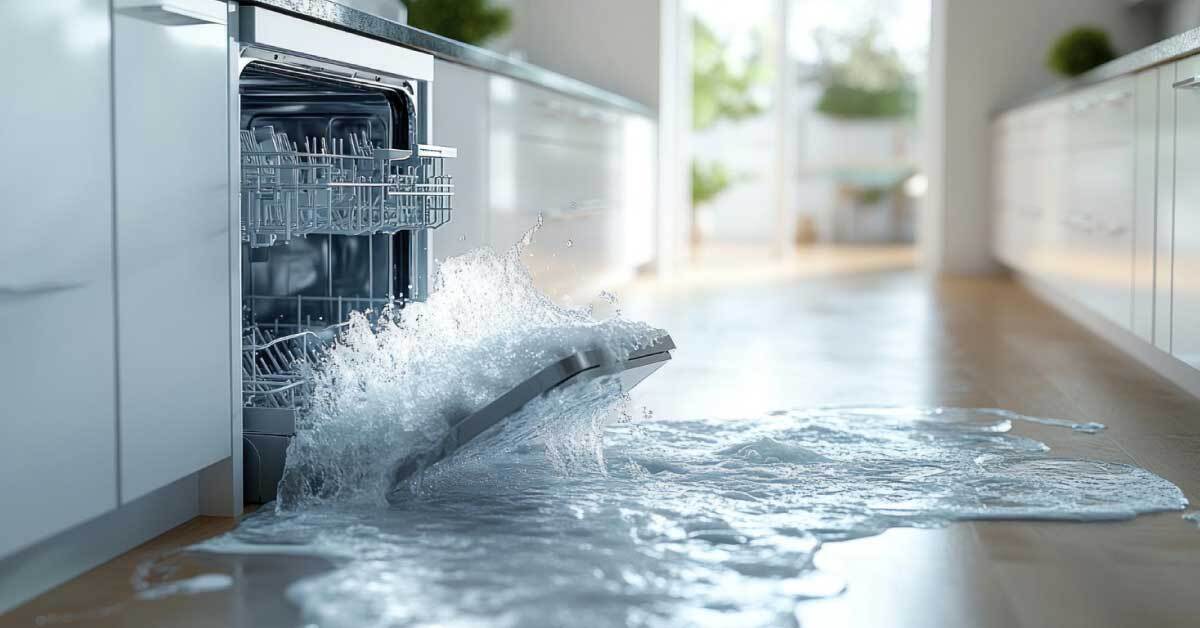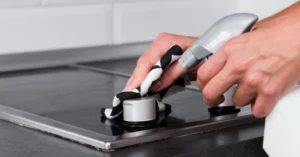A leaking dishwasher can transform your San Francisco kitchen into a watery disaster, especially in foggy neighborhoods like the Outer Richmond or Marina District where high humidity (averaging 75%) accelerates mold growth and corrosion. Whether it’s persistent leaks from the bottom causing floor damage in older Victorian homes with uneven floors or front-door spills in high-rises, this issue hikes utility bills and risks structural harm. But most dishwasher leaks stem from fixable problems like faulty seals or clogs, often exacerbated by San Francisco’s moderately hard water and salt air from the Pacific Ocean.
In this in-depth guide, we’ll cover the top causes of dishwasher leaking, step-by-step diagnostics, high-level fixes, and SF-specific prevention tips. Drawing from common entities like door gaskets, drain pumps, and spray arms, we’ll help you troubleshoot safely while knowing when to enlist certified technicians for brands like Bosch or LG. For professional dishwasher repair in San Francisco, visit our dishwasher repair service page for same-day service.
Top 9 Causes of Dishwasher Leaking
Dishwasher leaks often arise from wear, clogs, or installation issues, but in San Francisco’s coastal climate, factors like salt air corrosion on metal parts (e.g., heating elements) and seismic stresses from earthquakes can worsen them. Based on 2025 appliance trends, here are the nine most prevalent causes, with tailored advice for Bay Area residents.
1. Worn or Damaged Door Gasket
The rubber door gasket (seal) ensures a watertight closure. Over time, it cracks, hardens, or collects debris, leading to front leaks—common in SF’s humid fog belt where moisture speeds degradation.
How to Fix It:
- Inspect for tears or buildup; clean with mild soap.
- Replace by soaking a new gasket in warm water and fitting it from the top center.
- In salty coastal areas, check quarterly.
2. Faulty or Loose Door Latch
A bent or loose latch creates gaps, allowing water escape. Earthquakes in SF can misalign latches over time.
How to Fix It:
- Tighten with a screwdriver or replace.
- Test seal with a dollar bill—if it pulls easily, adjust.
3. Clogged or Damaged Drain Hose
Blockages or cracks cause backups and bottom leaks; SF’s hard water promotes mineral buildup in hoses.
How to Fix It:
- Disconnect power/water, remove kickplate, flush hose with a snake.
- Replace if cracked; tighten clamps.
4. Incorrect Detergent or Overuse
Wrong soap (e.g., hand dish soap) creates suds overflows; overuse overwhelms seals in busy urban households.
How to Fix It:
- Use dishwasher detergent only; adjust for hard water.
- Run vinegar cycle to clear suds.
5. Unlevel Dishwasher
Uneven units pool water, spilling over—prevalent in SF’s sloped, older homes.
How to Fix It:
- Use a spirit level; adjust front legs via kickplate screws.
- Retest post-adjustment.
6. Cracked or Clogged Spray Arm
Damaged arms cause erratic spraying and overflows; corrosion from salt air affects plastic/metal arms.
How to Fix It:
- Inspect/remove bottom rack; clean holes with a skewer.
- Replace cracked arms.
7. Faulty Water Inlet Valve
Stuck valves overfill, leading to side/bottom leaks; humidity corrodes electrical components.
How to Fix It:
- Access behind kickplate; replace if damaged—best for pros due to complexity.
8. Clogged Filter
Food/mineral clogs trap water, causing backups—exacerbated by SF’s water hardness.
How to Fix It:
- Remove bottom rack/filter; rinse debris.
- Clean monthly to prevent mold in humid climates.
9. Damaged Water Supply Line or Pump System
Cracked lines or worn pumps leak underneath; high water pressure in SF apartments strains connections.
How to Fix It:
- Check for hose wear; tighten or replace.
- Pump issues often need professional diagnostics.
Common Leak Causes, Parts Involved, and SF Impacts
| Cause | Key Parts/Entities | San Francisco Impact | Prevention Tip |
|---|---|---|---|
| Door Gasket Damage | Door Seal, Rubber Gasket | Humidity accelerates cracking | Clean quarterly |
| Loose Latch | Door Latch, Hinges | Seismic shifts misalign | Secure with straps |
| Clogged Drain Hose | Drain Hose, Clamps | Hard water minerals build up | Flush annually |
| Incorrect Detergent | Detergent Dispenser | Urban overuse in small kitchens | Use eco-formulas |
| Unlevel Unit | Leveling Legs, Tub | Uneven floors in old homes | Check after moves |
| Cracked Spray Arm | Spray Arm, Nozzles | Salt air corrosion | Inspect bi-monthly |
| Faulty Inlet Valve | Inlet Valve, Sensors | Moisture shorts electrics | Pro checkups |
| Clogged Filter | Filter, Drain Pump | Mold from fog humidity | Monthly rinse |
| Damaged Supply Line | Water Line, Pump Seal | Pressure in high-rises | Replace worn hoses |
Step-by-Step Guide to Troubleshoot Dishwasher Leaking in San Francisco
Follow this diagnostic process to identify leaks without risking further damage, considering local factors like limited space in SF apartments.
- Safety First: Unplug or breaker off; shut water valve. Mop spills to prevent slips on tile/wood floors common in Bay Area homes.
- Inspect Door Components: Check gasket and latch for wear; clean debris influenced by hard water residue.
- Run a Test Cycle: Observe leak location (front for seals, bottom for hoses) during a short cycle.
- Examine Internal Parts: Remove racks; inspect spray arms, filters, and hoses for clogs or cracks.
- Level and Align: Use a level; adjust for SF’s uneven terrain or post-quake shifts.
- Check Supply and Drain: Verify water line and pump for damage; flush with vinegar for minor clogs.
- Retest and Monitor: Run full cycle; note if humidity causes persistent issues.
When to Call a Professional for Dishwasher Repair in San Francisco
DIY suits simple fixes, but complex problems like pump seals or inlet valves demand experts, especially in time-strapped SF. Contact pros if:
- Leaks continue post-troubleshooting.
- Suspect pump damage, cracked tub, or electrical faults (e.g., corroded sensors from salt air).
- Water damage affects cabinets/floors, requiring restoration.
- Unit under warranty—DIY voids it.
- Uncomfortable with tools in compact kitchens.
Local services like All State Appliance Repair provide certified fixes for major brands (Bosch, Whirlpool, LG), addressing SF-specific corrosion with same-day response in neighborhoods like Nob Hill or Castro. can handle brands like Bosch, Maytag, and Whirlpool. Save time and avoid costly mistakes by scheduling a professional visit.
Preventing Future Dishwasher Leaks in San Francisco’s Coastal Environment
Extend lifespan (typically 7-12 years, shortened to 8-10 in humid SF) with these tips:
- Routine Maintenance: Clean filters/drains monthly; inspect gaskets for fog-induced mold.
- Detergent Best Practices: Use low-suds, eco-friendly options suited to hard water.
- Climate Adaptations: Add rust inhibitors for salt air; secure units against quakes.
- Professional Tune-Ups: Annual checks catch early corrosion or clogs.
- Load Properly: Avoid overfilling to prevent spray arm stress.
FAQs About Dishwasher Leaks in San Francisco
1. Why is my dishwasher leaking from underneath?
Often due to clogged drain hoses, faulty inlet valves, or unlevel units—worsened by SF hard water buildup. Inspect hoses and filters first.
2. How do I stop my dishwasher from leaking?
Identify source (e.g., gasket for front leaks); clean/replace parts. For persistent issues in humid areas, professional diagnostics prevent mold.
3. Is it worth fixing a leaking dishwasher?
Yes, if under 7-10 years and repairs cost less than half a new unit—especially for high-end models like Miele in SF homes.
4. How do I unclog a dishwasher drain?
Remove filter/rack; clean debris. Use vinegar for minor clogs from minerals; snake hoses for deeper blocks.
5. What is the life expectancy of a dishwasher?
7-12 years; SF’s humidity and salt air can reduce to 8-10 without maintenance.
6. Can a clogged drain cause a dishwasher to leak?
Yes, backups from filters/hoses lead to overflows—common with food residue in urban kitchens.
7. How much does it cost to fix a leaking dishwasher in San Francisco?
Typically in the low to mid-hundreds, varying by issue (e.g., gasket vs. valve). Get a local quote for accurate estimates.
Conclusion: Maintain a Leak-Free Dishwasher in San Francisco
A leaking dishwasher doesn’t have to disrupt your San Francisco lifestyle. Understanding entities like door gaskets, drain pumps, and spray arms empowers you to tackle dishwasher leaking effectively. In San Francisco’s foggy, salty environment, proactive steps prevent costly damage.
For expert intervention, visit our dishwasher repair page for reliable dishwasher repair.






